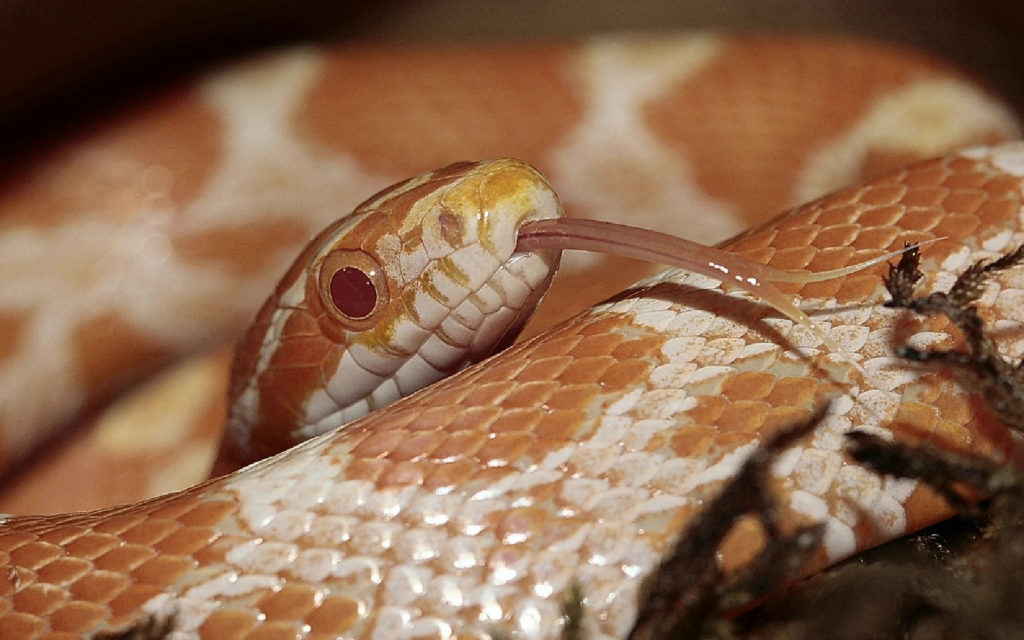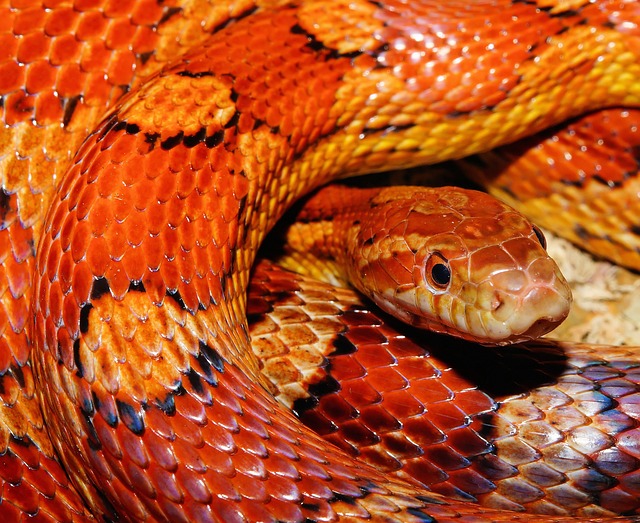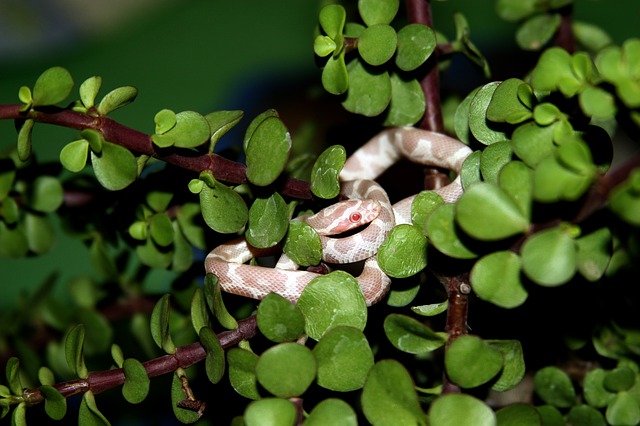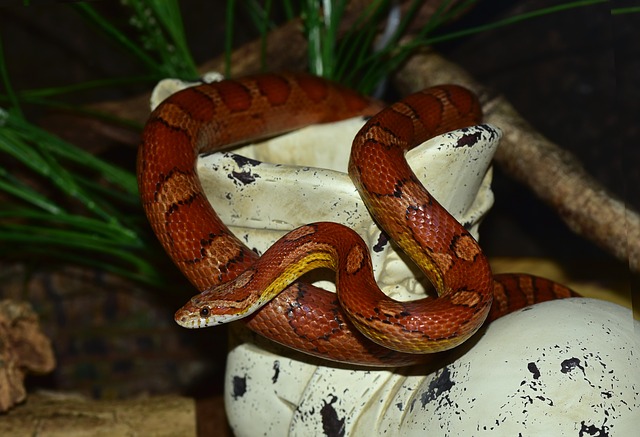Due to their relaxed temperament and relatively small size, corn snakes are quickly becoming the reptilian pet of choice for many snake lovers.
One of the biggest factors that make corn snakes such appealing pets is their wide variety of different colors and morphs.

Their distinctive markings make color variations popular – in fact, new corn snake morphs and color combinations are appearing constantly.
In this guide, we will go over morph terminology and a few of the most common and coveted types of corn snakes.
Quick Navigation
A Closer Look at the Corn Snake
Corn Snakes are a non-venomous variety of snakes most commonly found in North America.

Opinions are divided as to how the corn snake got its name. Some speculate its name is due to the markings on its belly appearing like an ear of corn, while others believe it is simply because this variety of snake is so often found in corn fields.
A Corn snakes’ defining features include its back markings, which are described as being dark-margined blotches, usually in shades of red or brown.
Corn snakes also commonly have two black stripes under their tails, and their underbellies are glossy white which the occasional orange or black marking, dependent on variation.
A corn snake’s head is also considered distinctive, with a coloured marking on their heads in a spear-like shape.
Also common in the head area are dark vertical bars around the lips or mouth. In regards to the corn snake’s eyes, it is typical for the iris to be orange or red, with round pupils.
Exploring Morphology
Morphs come from generations of careful breeding, and sometimes just random happenstance that is happily carried over into future generations by breeders.
By learning a bit about genetics and common types of morphs, you can get an idea of what goes into developing and maintaining new morphs within healthy breeding pools.
To help with that, we’ll cover some genetics terminology and talk a bit about the types of morphs you can expect to encounter. After all, it’s a little more complicated than how bright the colors are or whether the traditional pattern has been altered.

There are over 775 morphs and color variations in total, and in this article we’ll be taking a closer look at some of most unique and outstanding morphs, as well as some of the most popular.
We’ll also be learning a little more about the snakes in question, and just how such a wide variation of markings can be achieved in a single breed.
We’ll also talk a little bit about the importance of good breeding when considering morphs and color variations, and how the breeder you choose can affect everything from the colors available to you to the health of the pet you bring home.
Before we explore some of the stunning corn snake morphs which have been created, we should first take a closer look at how these variations are created.
Reptile morphology is a complex science. Therefore, we will only be exploring terms and concepts in their basic, most surface level form to give you a general idea of how such varying morphs are achieved.
Morphs can be either discovered or bred, with the latter option being the more common in regards to the pet industry.
In regards to the former, sometimes morphs are discovered in the wild. This is down to natural mutation, and these unique acquired traits can sometimes be passed on from the wild snake through breeding.
Breeding is the second and most typical option, and morphs are created when two snakes with desirable features or characteristics are bred to create offspring with a unique combination of these desired features.
Terminology
If you are looking to explore the world of reptile morphs more closely, then it is important to be familiar with some of the terminology used in regards to selective or genetic breeding.
- Genetic Traits – These are the characteristics we have determined by our genetics. In humans, for example, these are most commonly seen in facial features such as bone structure or nose shape.
- Recessive Traits – Recessive and dominant traits make up the basic two-sided coin of genetics. A recessive trait is one which comes from a recessive gene. To be successfully passed to the next generation both parents must feature these genes. In humans, the most common example of this is blue eyes.
- Dominant Traits – Dominant traits are the other side of our genetic coin analogy and unlike recessive traits, dominant traits will show up in the offspring even if just one of the parents carries the gene. In humans this is most clearly characterized by brown eyes.
- Co-Dominant Traits – As the name might suggest, this is where two dominant traits display equally within the offspring.
- Phenotype – This word literally means the characteristics of any organism which can outwardly be observed. In reptiles this can be features such as scale shape and colour, patterning, eye shape, and more.
- Genotype – This term is for the unique characteristics of a creature’s genetic makeup. Think of it as the reverse of phenotype, as it is the features we cannot see with the naked eye.
- Polygenic Traits – Also commonly referred to as ‘line breeding’ this refers to the practice of breeding a reptile with favored characteristic with another that has the same desired features. This is done with the aim of producing offspring which have the same, or an improved variant of the desired traits in question.
- Outcrossing – Where polygenic traits involve breeding species with same characteristics, outcrossing is the breeding of those whose features differ. There can be many reasons why a breeder might wish to do this. Most commonly it is to mitigate the increased risk of genetic defects which can come from selective or inbreeding. A breeder might also opt to practice outcrossing in the hopes of creating a specific outcome or new set of traits in a species.
- Homozygous – Corn snakes which are classed as ‘homozygous’ carry two genetic copies of the same trait, gained from each parent.
- Heterozygous – A corn snake which is ‘Heterozygous’ will have one copy of a wild or normal trait, and a copy of a designer or recessive trait.
Types of Corn Snake Morphs
There are several different types of morph, which each refer more or less to what has been changed or ‘morphed’ in the snakes phenotype, to suit the polygenic traits sought after by the breeder.
Color Morphs
The title of this morph is very self-explanatory.
A color morph corn snake is defined as being a snake which still has its recognisable dark ringed splotches, but differs in its typical coloration, which can either be seen in the background color, the marking color, or both simultaneously.
There can often be color morphed variants of pre-existing morphs, such as seen in scaleless corn snakes. This can increase the rarity, desirability, or value of the morph in question.
Pattern Morphs
Pattern morphs are where the corn snakes’ original hues of orange, red, brown, and black are retained, but the patternation of the snake has been altered.
A well known example of this would be the Okeetee corn snake, whose markings appear more as leopard prints than the corn snake’s typical characteristic splotches.
Other commonly seen types of pattern morphs are stripes or even a lack of pattern entirely.
Scale Morphs
This section of morphology constitutes any kind of morph where the physiology of the scales has been changed.
The most well-known example of this in recent years is the scaleless corn snake, which, as its name might suggest, lacks scales on the dorsal area of their bodies, showing their soft under skin in place of this.
Compound Morphs
This category basically represents the fusion of any one of the above morph types.
This type of morph happens when two other morphs of snake are bred together. Therefore, hypothetically, if a blood red corn snake and a topaz Corn Snake were bred together, the breeder would end up with a blood red topaz Corn Snake.
The same could be applied with breeds that feature scale morphs.
Of course, not all morphs can be bred together to successfully create compound morphs, as those with the majority of dominant traits would easily overpower the recessive genes of other snakes, resulting in offspring which closely resemble the dominant morphology, instead of representing a fusion of the two.
Common Corn Snake Morphs
There are a wide variety of common morphs which many snake owners may have encountered before. While these variants may be more frequently seen than others mentioned in this article, it by no means overshadows the individual beauty of each different morph.
Normal Corn Snake

The normal corn snake is the morph which most closely represents the patternation of wild snakes. This morph does have quite a degree of variance, but commonly will be an orange or a brown/ochre color, with black-ringed red blotches running down their back. Infant or juvenile normal corn snakes are typically duller in coloration that becomes more vibrant as they reach adulthood.
Blood Red Corn Snake
As the name might suggest, this morph has an overall blood red hue, with darker patches running down their backs. Typical blood red variants won’t have a corn snake’s distinctive black outlines around their scales.
Abbott’s Okeetee Corn Snake
If you’re a fan of leopard print, then you’ll love the markings of the Abbott’s Okeetee morph! This morph originated in South Carolina, and due to the clarity of their markings, is considered to be one of the ideal representations of the corn snake. The Okeetee morph has enlarged black outlines around the orange-brown splotches of back markings, creating a bold contrast.
Anerythristic Corn Snake
The anerythristic corn snake morph is devoid of all red pigments, and because of this, resembles a brown-toned camo pattern. The base hue of the snake is a pale tan, which contrasts nicely against the darker brown blotches. It is also not uncommon for this morph to have yellow markings along the jawline.
Hypomelanistic Corn Snake
If you’re in to your word origins, you’ll already know that this morph gets its name from the fact it lacks (hypo) dark brown or black (melanin) pigments. This gives the snakes markings a softer hue, as the blotches do not feature a typical corn snake’s characteristic black ring. Instead, the main pigments found on this snake are pale yellow and a terracotta red.
Albino Corn Snake
Where the previous snake on our list lacks some dark pigments, the albino morph lacks melanin entirely. From afar, these two corn snakes do look similar, but the Albino variant is far more pale, and has no pigmentation around the face area, leading to the pink eyes so associated with albinism\
Rare Morphs
Several factors impact the rarity of a morph. Oftentimes, newer morphs are extremely rare during the time it takes to successfully breed a saleable amount of the offspring. Another cause for morph rarity can be down to the difficulty of achieving the desired phenotypes, such as with quad homo morphs, which can be notoriously challenging to successfully breed.
Topaz Corn Snake
Considered to be one of the rarest morphs, there is also little information on the origins of this morph. The coloration of this snake closely mimics the stone from which it gained its name, and has an overall warm golden yellow hue. It features the classic patternation of a corn snake, which is coloured in golden tones of orange and brown. The iris of this snake can also be an attractive contrasting green, which adds to the overall uniqueness of this morph.
Tessera Corn Snake
When you see the stunning tessera corn snake for the first time, it’s not hard to see why this morph is so rare and desirable. A large amount of this morph’s colouration is dark burgundy to terracotta, with a base colour of pale tan. On the sides of its body the Tessera morph features classing Corn Snake markings, however it is the striking line along its back which makes this snake like no other.
Palmetto Corn Snake
Due to being relatively new on the market, this morph is rather elusive and expensive. This morph is white and patternless, and its most defining feature are the contrasting brown flecks that dapple the back of the snake, which some say looks like confetti sprinkled in snow.
Scaleless Corn Snake
This morph has been on the market for several years, however it only seems to be increasing in popularity. This morph is defined by the lack of scales in their dorsal area, which leaves the soft under skin exposed. There are various different sub-morphs of the scaleless corn snake, which some of the more unique coloured variants highly sought after.
Snopal Stripe (Glacial Stripe) Corn Snake
This morph is the snake embodiment of an opal. Similar to the blizzard snake, which is completely white, this snake has no markings, and instead has scales which appear to have an iridescent quality with tinges of lavender and mint depending on the direction of the light.
Just Plain Cool
As this article has already mentioned, there are so many different corn snake morphs, and while not all are valuable or rare, many are still stunning to behold. Here we’ll be listing some of our top mentions for those snakes whose markings or colorations really set them apart from the crowd.
Candy Cane Corn Snake
This morph is perfect for anyone who loves the holiday season. This snake features elements of an albino, with pink eyes and a pale white background colour. Its markings appear as red stripes, which is what gives this corn snake its festive appearance.
Lava Corn Snake
This variant has all the traditional markings of a corn snake, but with all the colors dialled up a notch. While the backgrounds of these snakes markings can appear pale or white when just hatched, once adulthood is reached it transforms into a fiery orange, the perfect accompaniment to its red/orange markings.
Granite Corn Snake
Where the lava corn snake takes the traditional markings and dials the color up a notch, the features of the granite corn snake are all about de-saturation. This morph has none of the warm tones of traditional corn snakes, as its markings have a diffused appearance about them, making them seem almost like a snow leopard from afar.
Butter Stripe Corn Snake
With its perfect butter candy coloration, this morph has various shades of yellow along its back and a white underbelly. Instead of the classic corn snake markings, the butter stripe corn snake, as the name suggests, has golden yellow stripes which run the length of its back. This morph is created by combining caramel, stripe and amelanistic genes.
Pastel Motley Corn Snake
This variant of the motley morph when fully grown has a pastel yellow body with soft pastel blue markings. When in its infancy, the snake’s colouring is an off-white with soft tan striping. The markings on this morph can vary from diamonds, to more abstract shapes.
Coral Snow Corn Snake
This morph features traits of albino corn snakes, but is actually a combination of the anerythristic, amelanistic, and hypomelanistic genes. These snakes feature the pink tinged features and irises of albinos, and can vary in the ratio of their colourings with some appearing more pink or orange, and some more on the yellow side. It is also not uncommon for this morph to develop light green borders around their markings.
Miami Corn Snake
This snake has been selectively bred over the years for its unique coloring. Named after the region of Florida it is indigenous to, this morph’s colouring features a high contrast between body color and marking color, with the body typically being a cool-toned gray, as opposed to the markings, which are usually an intense red.
Sunspot Corn Snake
Sunspot corn snakes have some of the quirkiest markings seen in any morph. With a peachy body colour and typically orange markings, these morphs feature a combination of blotches and stripes. The stripes usually appear as thin lines around the head area, which then lead into sparse blotches, reminiscent of a traditional corn snake’s markings. This morph also has rather intense eyes, with the dark pupil contrasting against the amber iris, making these fun little variants appear wide-eyed and as quirky as their markings.
The Importance of a Good Breeder
Having read about all the amazing morphs corn snakes can present with, you may been keen to adopt a scaly companion of your own. If that is the case, we most certainly say go ahead! After all, with their small to medium size and calm demeanour, they make great pets. However, the same as when you purchase any other pet, making sure you buy from a reputable breeder is essential.
When scoping out potential breeders, take note of how they act, don’t be afraid to ask questions, and if the breeder seems vague or keen to move your attention on to other topics, or seems to want to wash their hands of you as soon as you buy, then it’s probably best to take your custom elsewhere. Any breeder worth their salt will know every aspect of their work, and will offer a degree of aftercare post purchase. Don’t be afraid to research your prospective breeder online, either. There are many corn snake and reptile communities online who can often advise the best breeders in your area.
Buying from a reputable breeder is important, as it ensures the snake you are buying is healthy and well cared for. Less reputable breeders may practice excessive inbreeding to increase their yield of visually desirable offspring, which often impacts on the overall health of the specimen. Also, when buying from reputable sources, you are supporting the industry, making it harder for shady breeders to stay in business.
Final Thoughts
As mentioned in the beginning of this article, there are over 775 known corn snake morphs. In regards to discussing and exploring them, while touching on some of the most interesting examples, this article has barely scratched the surface. New and exciting morphs and variants are being created yearly, leaving all us snake lovers constantly guessing what our local breeders will come up with next!
I’m thinking of breeding a normal male to a snow corn. Will I have any visual babies or just gets?